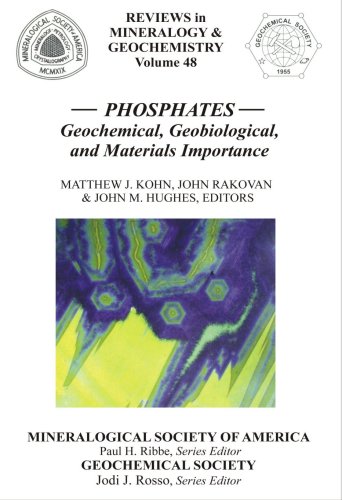

Mineralogy and Crystal Chemistry
· The Crystal Structure of Apatite, Ca5(PO4)3(F,OH,Cl)
-- J.M. Hughes & J. Rakovan
· Compositions of the Apatite-Group Minerals: Subsitution
Mechanisms and Controlling Factors -- Y. Pan & M.E Fleet
· Growth and Surface Properties of Apatite -- J. Rakovan
· Synthesis, Structure and Properties of Monazite, Pretulite
and Xenotime -- L. Boatner
· The Crystal Chemistry of the Phosphate Minerals -- D.
Huminicki & F. Hawthorne
Petrology
· Apatite in Igneous Systems -- P. Piccoli & P. Candela
· Apatite, Monazite, and Xenotime in Metamorphic Rocks
-- F. Spear & J. Pyle
· Electron Microprobe Analysis of REE in Apatite, Monazite
and Xenotime: Protocalls and Pitfalls -- J. Pyle, F. Spear, &
D. A. Wark
· Sedimentary Phosphorites: An Example: Phosphora Fromation,
Southern Idaho, USA. -- A.C. Knudsen & M.E. Gunter
· The Global Phosphorus Cycle -- G. Filippelli
Biomineralization
· Calcium Phosphate Biominerals -- J.C. Elliott
· Stable Isotopes Compositions of Biological Apatite --
M. Kohn & T. Cerling
· Trace elements in Recent and Fossil Bone Apatite -- C.
Trueman & N. Tuross
Geochronology
· U-Th-Pb Dating of Phosphate Minerals -- M. Harrison,
E. Catlos, & J-M. Montel
· (U-Th)/He Dating of Phosphate Minerals -- K. A. Farley
& D. F. Stockli
· Fission Track of Phosphate Minerals and the Thermochronology
of Apatite-- A. G. W. Gleadow, D. X. Belton, B. P. Kohn &
R. W. Brown
Materials Applications
· Biomedical Application of Apatites -- K.A. Gross &
C.C. Berndt
· Phosphates as Nuclear Waste Forms -- R.C. Ewing &
L. Wang
· Apatite Luminescence -- G. Waychunas
We are pleased to present this volume entitled Phosphates: Geochemical, Geobiological and Materials Importance. Phosphate minerals are an integral component of geological and biological systems. They are found in virtually all rocks, are the major structural component of vertebrates, and when dissolved are critical for biological activity. This volume represents the work of many authors whose research illustrates how the unique chemical and physical behavior of phosphate minerals permits a wide range of applications that encompasses phosphate mineralogy, petrology, biomineralization, geochronology, and materials science. While diverse, these fields are all linked structurally, crystal chemically and geochemically. As geoscientists turn their attention to the intersection of the biological, geological, and material science realms, there is no group of compounds more germane than the phosphates.
This book is divided into five sections: Mineralogy, Petrology, Biomineralization, Geochronology, and Materials Science. In the first section, three chapters are devoted to mineralogical aspects of apatite, a phase with both inorganic and organic origins, the most abundant phosphate mineral on earth, and the main mineral phase in the human body. Monazite and xenotime are highlighted in a fourth chapter, which includes their potential use as solid-state radioactive waste repositories. Section 1 concludes with the most detailed extant examination of the crystal chemistry of other naturally-occurring phosphate phases.
In the second section, on petrology, three chapters detail the igneous, metamorphic, and sedimentary aspects of phosphate minerals. A fourth chapter provides a detailed look at analyzing phosphates for major, minor, and trace elements via the electron microprobe. A final chapter treats the global geochemical cycling of phosphate, a topic of intense current geochemical interest.
The third section, on biomineralization, begins with a summary of the state of research on bone, dentin and enamel phosphates, a topic that crosses disciplines that include mineralogical, medical, and dental research. The following two chapters treat the stable isotope and trace element compositions of modern and fossil biogenic phosphates, with applications to paleontology, paleoclimatology, and paleoecology.
The fourth section, on geochronology, focuses principally on apatite and monazite for U-Th-Pb, (U-Th)/He, and fission-track age determinations, and covers both classic geochronologic techniques as well as recent developments.
The final section of this volume, on material applications, highlights how phosphate phases play key roles in fields such as optics, luminescence, medical engineering and prosthetics, and engineering of radionuclide repositories. These three chapters provide a glimpse of the use of natural phases in engineering and biomedical applications and illustrate fruitful areas of future research in geochemical, geobiological and materials science. We hope all chapters in this volume exhort researchers to expand the scope of research on all aspects of natural and synthetic phosphate compounds.
This volume has benefited from the efforts of numerous colleagues. First and foremost, Paul H. Ribbe continues to produce a remarkable series, and we are deeply indebted to him for his continuing efforts on this volume. The US Department of Energy generously provided funds to help defray publication costs. All the authors worked diligently to produce and revise their chapters, and the volume editors are deeply appreciative of their efforts. Chapter reviews were provided by Serena Best, Adele Boskey, John Ferry, Karl Föllmi, Gerhard Franz, John Hanchar, Tony Hurford, John Jaszczak, Bradley Joliff, Paul Koch, Barry Kohn, Lee Kump, Al Meldrum, Rick Murray, Yuangming Pan, Randy Parrish, Richard Reeder, Christian Rey, Lois Roe, George Rossman, Cathy Skinner, Jeffrey Tepper, Chris Thomas, Günther Wagner, William White, David Williams, and Peter Zeitler, in addition to several anonymous reviewers. The volume was greatly improved by their thorough and timely efforts. We hope that we have done justice to all your hard work, as well as to all phosphates.
Matthew J. Kohn
Columbia, SC
John Rakovan
John M. Hughes
Oxford, OH
August 17, 2002